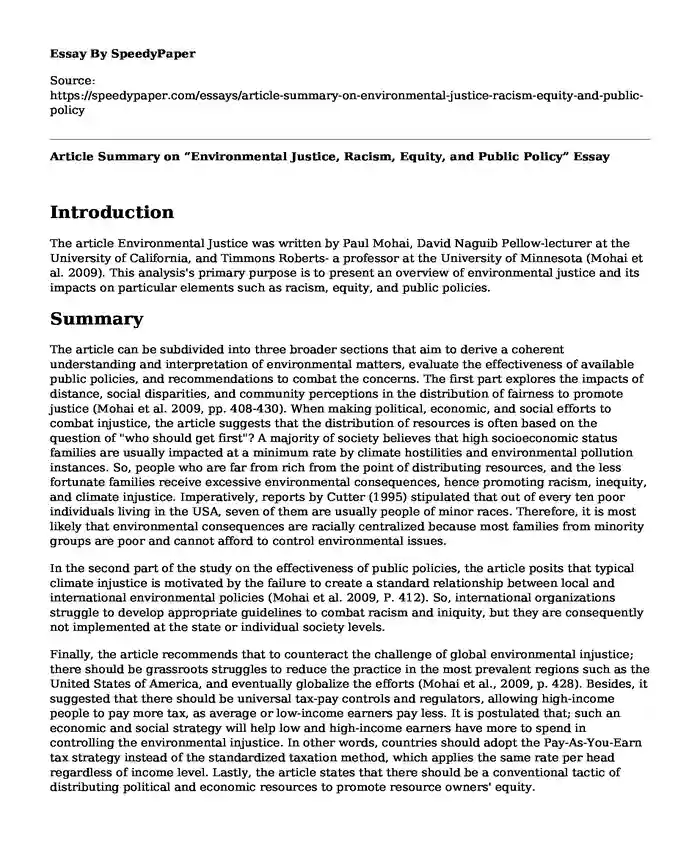
| Type of paper: | Essay |
| Categories: | Racism Justice Equity Public policy |
| Pages: | 3 |
| Wordcount: | 659 words |
Introduction
The article Environmental Justice was written by Paul Mohai, David Naguib Pellow-lecturer at the University of California, and Timmons Roberts- a professor at the University of Minnesota (Mohai et al. 2009). This analysis's primary purpose is to present an overview of environmental justice and its impacts on particular elements such as racism, equity, and public policies.
Summary
The article can be subdivided into three broader sections that aim to derive a coherent understanding and interpretation of environmental matters, evaluate the effectiveness of available public policies, and recommendations to combat the concerns. The first part explores the impacts of distance, social disparities, and community perceptions in the distribution of fairness to promote justice (Mohai et al. 2009, pp. 408-430). When making political, economic, and social efforts to combat injustice, the article suggests that the distribution of resources is often based on the question of "who should get first"? A majority of society believes that high socioeconomic status families are usually impacted at a minimum rate by climate hostilities and environmental pollution instances. So, people who are far from rich from the point of distributing resources, and the less fortunate families receive excessive environmental consequences, hence promoting racism, inequity, and climate injustice. Imperatively, reports by Cutter (1995) stipulated that out of every ten poor individuals living in the USA, seven of them are usually people of minor races. Therefore, it is most likely that environmental consequences are racially centralized because most families from minority groups are poor and cannot afford to control environmental issues.
In the second part of the study on the effectiveness of public policies, the article posits that typical climate injustice is motivated by the failure to create a standard relationship between local and international environmental policies (Mohai et al. 2009, P. 412). So, international organizations struggle to develop appropriate guidelines to combat racism and iniquity, but they are consequently not implemented at the state or individual society levels.
Finally, the article recommends that to counteract the challenge of global environmental injustice; there should be grassroots struggles to reduce the practice in the most prevalent regions such as the United States of America, and eventually globalize the efforts (Mohai et al., 2009, p. 428). Besides, it suggested that there should be universal tax-pay controls and regulators, allowing high-income people to pay more tax, as average or low-income earners pay less. It is postulated that; such an economic and social strategy will help low and high-income earners have more to spend in controlling the environmental injustice. In other words, countries should adopt the Pay-As-You-Earn tax strategy instead of the standardized taxation method, which applies the same rate per head regardless of income level. Lastly, the article states that there should be a conventional tactic of distributing political and economic resources to promote resource owners' equity.
Reaction
Typically, the article explores one of the most recent global challenges, which is environmental justice. I tend to agree with the fact that the risks of pollution and adverse climatic changes are not evenly distributed. This is triggered by the effects of unfair distribution of the human resources which are available in nature. Certainly, minor races, low-income earners, and marginalized groups of people are excessively affected, probably because they lack the necessary knowledge, skills, and power to control the effects. Meanwhile, I tend to disagree with the fact that revising the tax payment policies would act as the most proficient way to revive environmental justice. Instead, I believe that international and local organizations fighting for environmental justice should collaborate with economic institutions to create job opportunities for the large unemployed population across the globe (Cutter, 1995). This will allow more people to fight for justice at the individual level, and the results would concurrently spread to become international.
References
Cutter, S. L. (1995). Race, class, and environmental justice. Progress in human geography, 19(1), 111-122. https://journals.sagepub.com/doi/abs/10.1177/030913259501900111
Mohai, P., Pellow, D., & Roberts, J. T. (2009). Environmental justice. Annual review of environment and resources, 34, 405-430. https://www.annualreviews.org/doi/abs/10.1146/annurev-environ-082508-094348
Cite this page
Article Summary on "Environmental Justice, Racism, Equity, and Public Policy". (2023, Dec 07). Retrieved from https://speedypaper.com/essays/article-summary-on-environmental-justice-racism-equity-and-public-policy
Request Removal
If you are the original author of this essay and no longer wish to have it published on the SpeedyPaper website, please click below to request its removal:
- Investment Essay Sample: Risk and Returns Analysis
- Essay Sample on the Impacts and Treatment for Synthetic Designer Drugs
- Free Essay Exploring Myths, Misconceptions, and Stereotypes about Disability and Poverty
- Essay Sample for Students: Ethics and Criminal Justice Participants
- Essay Sample on Bullying Across Race and Gender
- The Five Fabulous Fashion Nights in New York - Free Essay
- Paper Example. Future of US Healthcare
Popular categories




